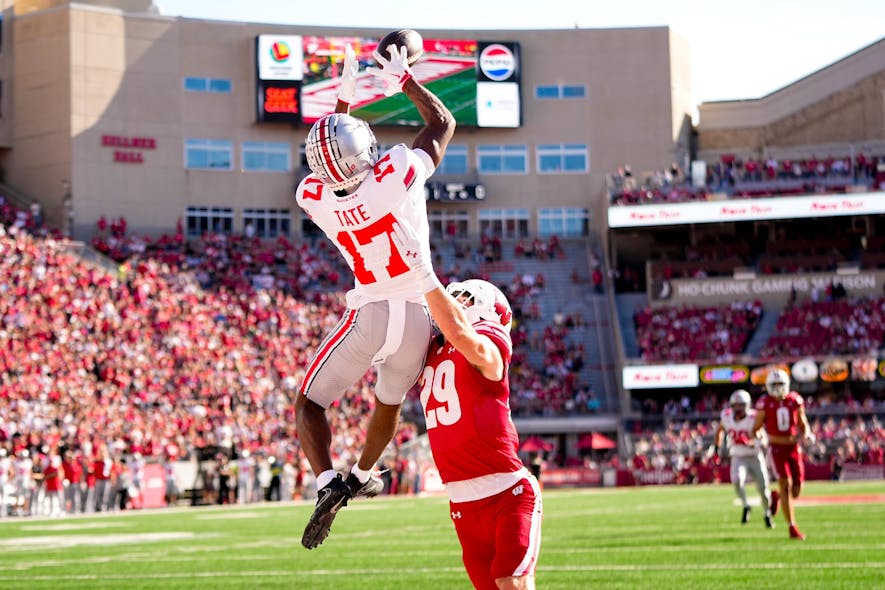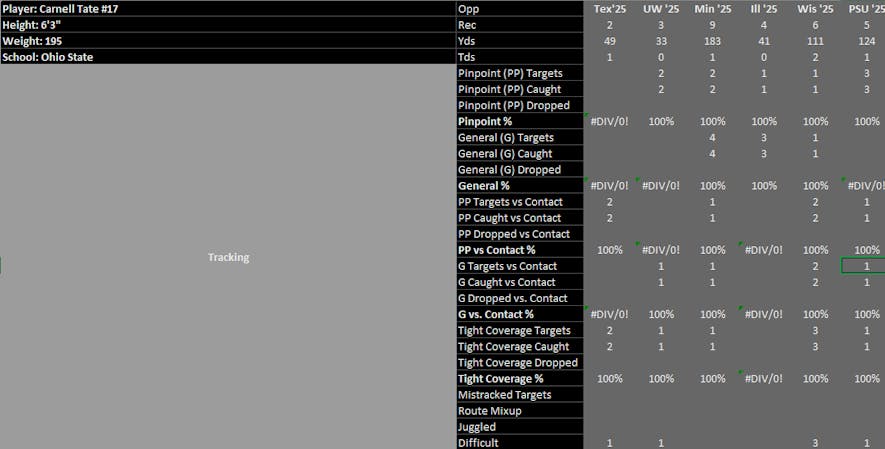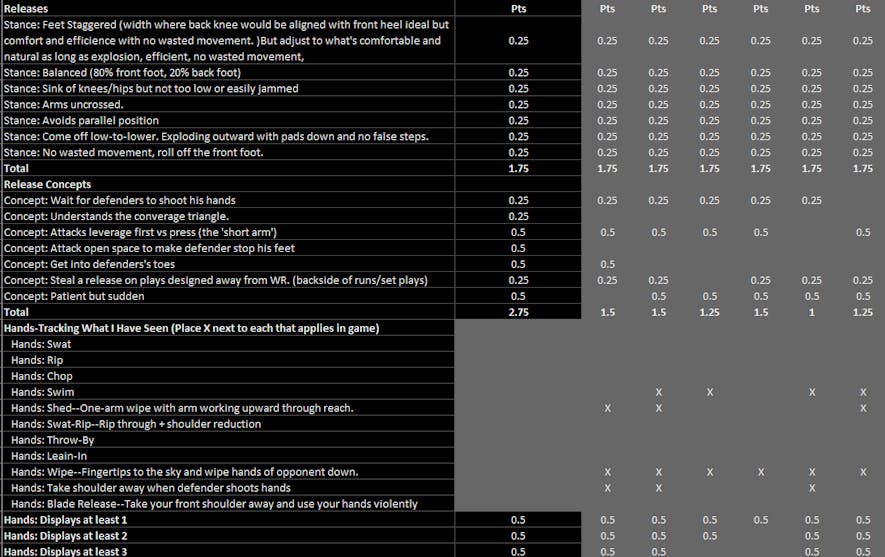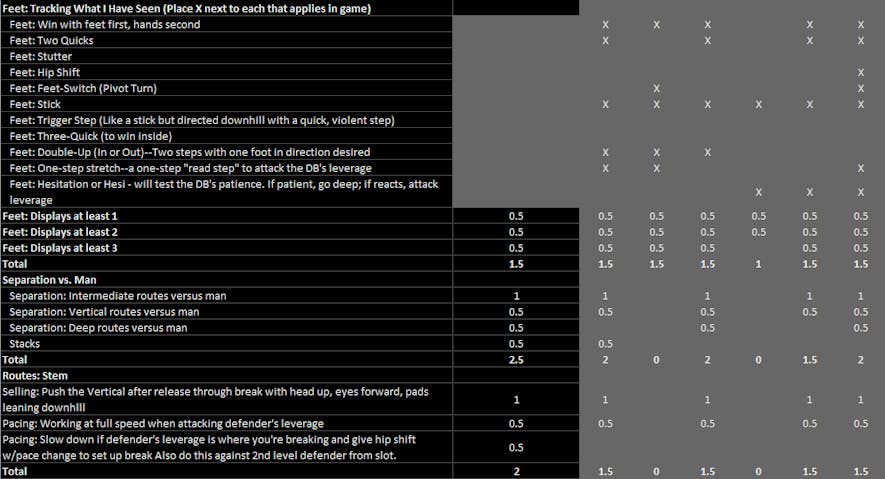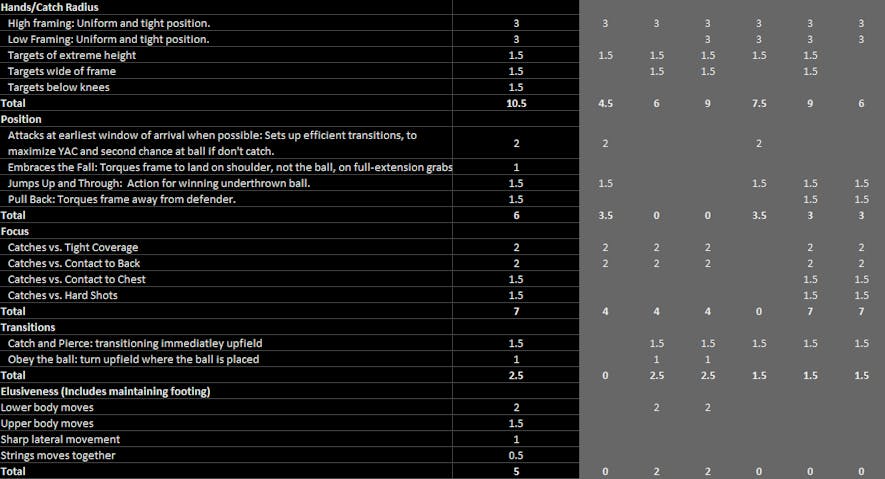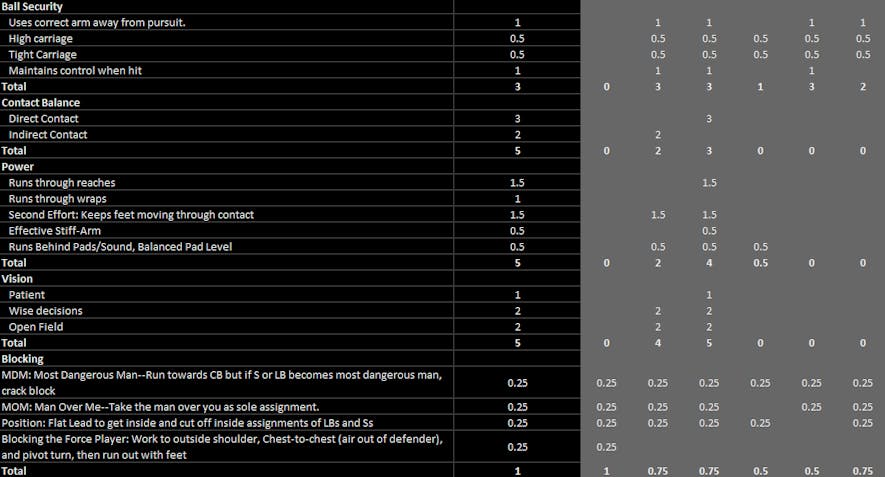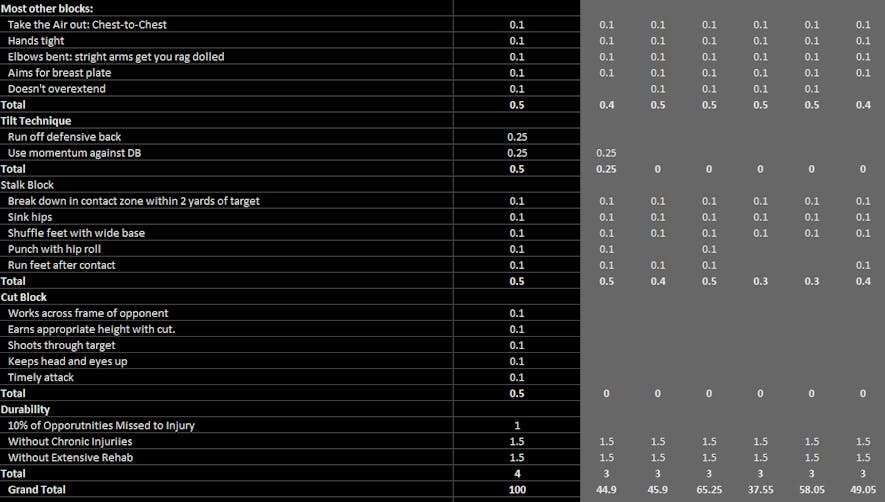Carnell Tate Is a Pro Receiver In Disguise
Carnell Tate might be a fake name. I have half the mind to call for an investigation of the Ohio State Athletic Department, because it wouldn't surprise me if Justin Jefferson went back to school and decided to play football on Saturdays under the stage name of "Carnell Tate."
Carnell Tate and Justin Jefferson weigh 195 pounds. They run excellent routes, take a physical approach as run blockers, and make some of the most impressive catches you'll see.
Tate is listed as 6-foot-3 while Jefferson is listed at 6-foot-1, but we know how these programs fudge physical dimensions for their own devices. The Buckeyes have to throw off the scent of suspicion somehow.
I'm not buying it.
If you couldn't tell, impressed might be a tame way of describing my thoughts on Carnell Tate's film. A comparison to Justin Jefferson is no small statement.
Last week, I shared a preliminary scouting report on Makai Lemon. If Lemon has the ceiling to have a career path similar to Amon-Ra St. Brown, Carnell Tate's path could be similar to Jefferson's.
The Rookie Scouting Portfolio
If you know about the RSP and my process, skip to Carnell Tate's Depth of Talent assessment or his film in the final two sections of this article. Otherwise, read on, because you'll gain a better understanding of a resource that has been pleasantly shocking readers since 2006...
The RSP -- The Rookie Scouting Portfolio -- is preparing for its 21st season of publication. If you're not familiar, you can go here to buy the 2026 publication at a pre-sale discount beginning this Friday, November 28.
You can also go to the link to learn about the pre-draft publication that's available every April 1, the post-draft publication that comes with the purchase, and my dynasty rankings and projections package, which is a separate service.
The pre-sale ordering period at a discount usually lasts a month. Most returning subscribers -- and you should know that most new subscribers become long-time subscribers -- wait until I end the discount period because they already believe what I offer for the money is a big discount.
This scouting report of Carnell Tate will give you a small taste of what you get with the RSP. We'll begin with the game tracking.
I try to make the RSP's process as transparent as possible. It's a process that multiple scouts and analytics professionals working directly for NFL GMs have praised. One in particular who has an extensive background in both arenas told me back in 2011 that the process was "light years ahead" of the NFL's system for evaluating film.
We're not talking about my skill as a scout, but the method for defining, tracking, and scoring prospects, and the continuous improvement philosophy baked into the process.
Here's Carnell Tate's Game Charting that I've done thus far for 2025. This is the first section of an extensive checklist of defined and weighted criteria that I use to grade a player.
Let's define two things that you'll see below. Pinpoint Targets are throws that arrive exactly where they're intended to go based on the receiver's route and the coverage.
A pinpoint target can be a throw delivered in stride on the receiver's numbers. It can also be a target throwing the receiver open or protecting the receiver from an oncoming defender that requires the receiver to make an adjustment to the ball -- even a difficult one. Carnell Tate has his share if pinpoint targets that weren't easy adjustments.
General Targets are throws that aren't placed exactly where they're intended based on the receiver's route and the coverage. For example, Carnell Tate runs a crossing route with no defender within 10 yards of him, and the quarterback throws the ball high and away from Tate's break path that forces him to high-point the ball past the boundary but still in range for him to easily get his hands on the ball.
This isn't an ideal target for Carnell Tate, but it's catchable. It's one of those plays where if he dropped it, you'd say the throw wasn't where it should have been, but Tate should have made the catch.
Difficult Catches are targets that have too many obstacles with placement, velocity, adjustments required, and defenders looming to say the receiver should have made the catch, but they do. We'll see some of those in Carnell Tate's scouting report.
As you can see, I have tracked six games of Carnell Tate's this year, and I have yet to see him drop a pass. My definitions for catchable targets and drops may differ from stat services. I tend to find I have high standards, which historically serves readers best.
There are 23 targets on this tracking chart that I deemed catchable, and 6 I judged as difficult. Carnell Tate caught all of them. Of these 29 targets, 11 were against contact and 8 were against tight coverage.
Despite seeing 20 fewer targets for Carnell Tate in the same number of games I tracked for Makai Lemon, Tate had more difficult catches and the same number of catches against contact. Both receivers have the most reliable mitts I've seen this year from the 2026 receiver class. Carnell Tate is the more dynamic athlete of the two.
Here's the rest of the checklist. I'm not going to do much explaining with the rest of these pictures. You'll see categories with criteria and weight scores. You'll also see whether Carnell Tate performed these criteria.
If he didn't, he either didn't show he could do it or he didn't perform it in a satisfactory fashion. I'll provide this context in Carnell Tate's written scouting report and in other sections of the RSP.
As you can see, this is an extensive list of what's expected from Carnell Tate as a wide receiver. This checklist of criteria is a list of basic wide receiver skills that formulate my Breadth of Talent Score.
I take all of the games and create one score based on what they've done in all of the games. All of my grades are on a 100-point scale, and I provide a key that explains the ranges and what they mean for a player's current skill set and potential development. Breadth of Talent tells the reader how many basic skills a prospect displays that a team might seek from a wide receiver.
Carnell Tate's Breadth of Talent Score is 86.25 out of 100. This is an excellent score and indicates that Tate has enough basic skills to contribute to a team and likely in a variety of receiver roles if called upon.

